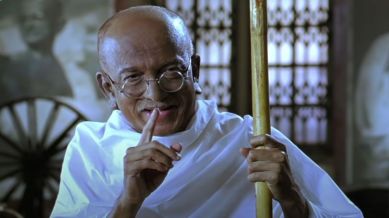Click here to join Express Pune WhatsApp channel and get a curated list of our stories
Gandhi’s ideology reminds us that real change begins with courageous action, says Gandhi of Munnabhai MBBS and Babuli of Dashavtar
Artists have both privilege and responsibility. Through storytelling, we allow people to see the world through another’s eyes.

From portraying Mahatma Gandhi in Lage Raho Munna Bhai to the unforgettable mentally challenged child in Chaukat Raja, and now stepping into the layered role of Babuli in Dashavtar, veteran actor, writer, and theatre stalwart DILIP PRABHAVALKAR speaks to NEHA RATHOD on the timeless pull of storytelling that resonates with culture and is delivered with simplicity.
Q: Dashavtar, your recent release, has not only received critical praise but also crossed Rs. 21 crore at the box office within two weeks. The film beautifully weaves folklore with the urgent concern of environmental degradation. What, according to you, makes it resonate so deeply with audiences?
monthly limit of free stories.
with an Express account.
A: Dashavtar connects because it speaks to something very human — the balance between progress and preservation. Though rooted in the folk theatre tradition of the Konkan region, the story feels very contemporary. My character Babuli is a man holding on to his art and faith even as the world around him changes. That struggle — between old values and new realities — is something everyone relates to. The film’s message about protecting both nature and culture is told with heart, not preaching. When truth is expressed through performance, music, and emotion, it stays with people. I think audiences see a bit of themselves in Babuli’s strong belief system and his quiet strength.
Q: Tell us more about Babuli and what drew you to this role.
A: Babuli is an ageing performer of the traditional Dashavatar theatre of Konkan. Despite failing eyesight and frail health, he refuses to give up his art. The villagers call him “half mad”, but this madness is really his devotion — to his craft, to his belief. Life tests him, yet he endures. I was drawn to the story because it celebrates Marathi culture while exploring perseverance and the human spirit. In times as uncertain as ours, this story felt deeply relevant.
Q: The film highlights the power of performance and storytelling. How do such cultural stories help keep communities connected?
A: Stories bind people together. Films like Dashavtar carry wisdom, values, and traditions — they make audiences reflect, talk, and remember. Good cinema lingers. It inspires empathy and helps communities stay rooted while moving forward. When stories are honest, they live beyond the screen.
Q: You’ve portrayed Babuli, Gandhi, and many other memorable roles. What makes you say yes to a character?
A: Experience teaches you to sense the possibilities of a role. I’ve been lucky that such meaningful characters have come my way — the mentally challenged child in Chaukat Raja, Gandhiji in Munnabhai, the possessed doll Tatya Vinchu in Zapatlela, or now the half-mad Babuli. What draws me each time is the chance to explore something new — to find a fresh layer within myself and share that with audiences. Reinvention keeps an actor alive, and that curiosity still drives me after all these years.
Q: Your portrayal of Gandhi in Munnabhai was humorous yet deeply powerful. Do you think audiences connect more when serious ideas are presented with warmth and simplicity?
A: Absolutely. Humour and warmth break barriers. Serious ideas, when shown simply, become relatable. Simplicity carries truth in a way complexity does not. That’s why audiences remember — not because something was intellectual, but because it was honest and felt close to life.cWhen films reflect real struggles, they don’t just entertain — they provoke discussion and inspire introspection.
Q: In today’s world of conflict and division, which part of Gandhi’s thought do you think we need most urgently?
A: Positivity. It may sound simple, but optimism is strength, not naivety. We need to believe that small acts of truth, compassion, and understanding can still make a difference. Gandhi’s ideology reminds us that real change begins with steady, courageous action.
Q: You’ve worked across theatre, cinema, and writing. What role do artists play in shaping conversations about peace and humanity?
A: Artists have both privilege and responsibility. Through storytelling, we allow people to see the world through another’s eyes. Honest art builds empathy, breaks prejudice, and encourages reflection. Even small stories can shape big conversations about humanity and kindness — that’s the quiet power of art.
Q: Two of your iconic characters — Gandhi and Babuli — both stand for conviction and inner strength. Do you see a link between them?
A: Very much so. Both believe deeply — one in truth, the other in art. Their dedication may seem quiet, but it’s unshakable. Whether Gandhi’s non-violence or Babuli’s love for performance, both remind us that faith and persistence can transform not just individual lives, but also those watching them.
Click here to join Express Pune WhatsApp channel and get a curated list of our stories